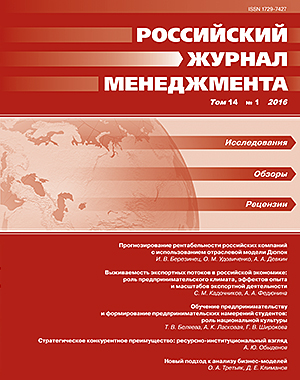Стратегическое конкурентное преимущество: ресурсно-институциональный взгляд
DOI:
https://doi.org/10.21638/spbu18.2016.104Аннотация
В статье представлена многоуровневая модель, ориентированная на формирование механизмов обеспечения стратегического конкурентного преимущества фирмы. Предложен оригинальный подход к определению конкурентного преимущества и анализу механизмов обеспечения его устойчивости в рамках двумерной логики. Использована техника разделяющего равновесия для выяснения условий устойчивого конкурентного преимущества. В этом контексте определены границы изменения экономической ренты и обоснована необходимость существования асимметрии в стоимости трансакционно-специализированных инвестиций для фирмы и ее конкурентов. Рассмотрены фундаментальные источники такой асимметрии. Проанализирована важность разделяющего сигнализирования о свойствах продукции с целью обеспечения устойчивого конкурентного преимущества. Показана полезность использования модели «заложник» для обеспечения непрерывности и эффективности трансакции, гарантирующей конкурентное преимущество. Приводится обоснование управления такой трансакцией с помощью отношенческого контракта между собственниками специализированных активов.
Ключевые слова:
стратегическое управление, конкурентное преимущество, ресурсный подход, экономическая теория контракта, новая институциональная экономическая теория
Скачивания
Библиографические ссылки
REFERENCES IN LATIN ALPHABET
Translation of references in Russian into English
Загрузки
Опубликован
Как цитировать
Выпуск
Раздел
Лицензия
Статьи журнала «Российский журнал менеджмента» находятся в открытом доступе и распространяются в соответствии с условиями Лицензионного Договора с Санкт-Петербургским государственным университетом, который бесплатно предоставляет авторам неограниченное распространение и самостоятельное архивирование.





